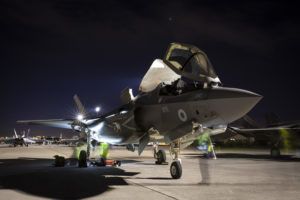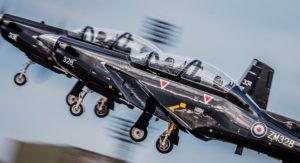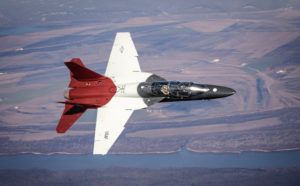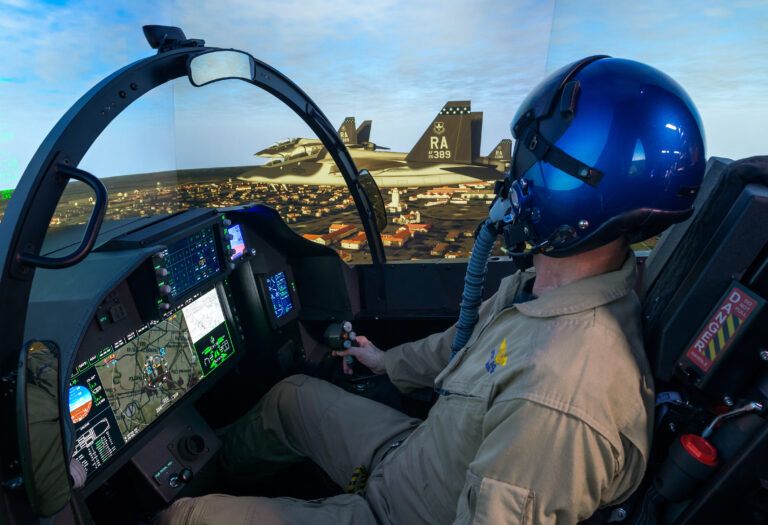by Paul Eden
Much has been written on the fact that there is no two-seat F-35, placing the onus for conversion onto type squarely in the simulator. Speak to pilots who’ve made the transition though, and it’s abundantly clear just how good the simulator experience is. So good, in fact, that Group Captain Jim Beck, Station Commander at Royal Air Force Marham, the UK’s F-35B Lightning operational base, describes it as the “synthetic environment”.
There is unanimous agreement that the aircraft flies exactly like the simulator. In the past, the simulator was often an approximation, where pilots practised emergency procedures, learned cockpit tasks and familiarised themselves with new systems.
The synthetics created for fourth-generation fighters created a stepping stone to the F-35. The Eurofighter Typhoon’s synthetic environment is so good that the RAF has achieved a synthetic training to live flying ratio of close to 50:50. That’s also true for operational F-35 training on 617 Squadron, while 207 Squadron, the Lightning operational conversion unit, trains pilots through a 60:40 balance. The Lightning’s synthetic and live environments were always considered inclusive and complimentary, to the extent that RAF Marham’s Lightning Integrated Training Centre (ITC) should almost be considered as four dedicated training jets.
Access to the ITC is restricted, but Group Captain Beck, a former Tornado and, more recently, F-35 pilot, says: “New pilots and engineers begin synthetic training immediately, the pilots sit at a desk equipped with a throttle and stick connected to an interactive network. They are also issued with their own set of inceptor sticks and a touchscreen laptop, helping them build muscle memory as they work through the many different modes on each system.
“This introduction to the F-35 synthetic journey also talks pilots through engine, mission and secret systems, the latter stored in our vaults. The system then examines students and re-teaches areas that will benefit from additional tuition.
Avatar training

“Our engineers undertake what we call avatar training, where they use a portable mission planning aid at a screen and work through complex maintenance evolutions. Behind one panel, for example, there could be 250 fasteners and because it’s covered in low-observable paint, it’s not practical to remove it for training. We take them all around the jet with this avatar training,” says Beck.
The pilot’s training progresses along a route where they learn everything they need to know before they go flying. “Once they’ve been examined and reached the required standard,” he continues, “we raise their level of classification and allow them into the vault. At that point they’re introduced to what most people would regard as a cockpit. “We have four FMS [full mission simulators] with 360° domes, helmet-mounted displays, full cockpits and the jet’s software. The simulator is accredited by RAF test pilots to be a direct and exact representation of how the jet will perform in the air. Where there are caveats or discrepancies, the test pilots have captured them and
noted shortfalls.”
Beck acknowledges that however good the simulator, it’s not real flying. “The effects of g, of pumped oxygen, are not simulated, but we capture all that and then work out how to generate that experience and ensure we think about it during the initial live sorties.”
Ironically, at this point students learn emergency procedures and the basics of controlling what Beck describes as “an easy jet to fly”. Then they go flying for real, before moving on to the next phase. “This is when the difficult part begins, teaching them how to operate the F-35. It’s the most important part of what we do in the synthetic environment and consumes almost all of our course time.”
Enhanced complexity
The Group Captain continues: “We progressively enhance the complexity of the scenarios, loading the students up. After each stage we put them back in the live environment, which confirms that what they’re doing in the synthetic environment is correct.” It’s a process that makes sense for the pilot and applies to the environment itself.

Operating in the live environment provides assurance that the synthetic is accurate. It gives pilots confidence in the air and assures them that how they are taught in the simulator will translate exactly into combat. “We’re using live flight to confirm what we’ve practiced in the synthetic environment,” Beck says, “it’s a fundamental pivot that will continue moving us towards a balance where we learn to fight in the synthetic environment and confirm in the live.”
Meanwhile, tacticians have always sought to keep their game plans and ultimate capabilities secret.
Participation in the US Air Force’s Red Flag exercises is considered about as close to real combat as a pilot gets without actually engaging an enemy, but Beck says the F-35 synthetic environment allows operators to go beyond even that level of training. “We’re expanding the complexity of the work we do in the synthetic environment, exploring tactics and using all of the jet’s capabilities.” Which makes absolute sense in the ITC, however the UK’s F-35Bs also go to sea, taking pilots away from Marham for extended periods.
The solution is in two deployable mission rehearsal trainers. “There are two cockpits in each,” Beck explains, “which we can link together to build a four-ship, just as we can the cockpits in the ITC, and our pilots and engineers can rehearse forthcoming missions in them.
“They have the same software as the FMS, but without the full 360° dome. This means they can be deployed to other bases and we’ve already fitted them to HMS Queen Elizabeth.”
While the ITC’s ‘cockpits’ are networked together, data security concerns are driving a cautious appraisal of how they could be linked with UK military synthetic training devices at other sites. The possibility of networking with a US-style ITC when US Air Force F-35As move to nearby RAF Lakenheath is tantalizing.
Still, there is a military truism that few plans survive first contact with the enemy and so it is easy to question the wisdom of depending on the simulator for high-end warfighting capability, yet Beck’s confidence in the accuracy of the F-35’s synthetic world underpins his enthusiasm for it. “Imagine making dots on a piece of paper,” he says. “They represent our envelope, our warfighting capability. One dot might represent the maximum g we can pull at a certain speed, while another dot shows maximum missile range. We select a dot and replicate it in the real world, check that we have it accurately placed on our ‘paper’ and assure ourselves we’ve replicated it exactly in the synthetic environment, where we put multiple dots together.”
The work relies on 17 Squadron, the UK Lightning Operational Evaluation Unit and Beck’s previous command, plus US F-35 test assets at Edwards Air Force Base, California, which collect data at those precise points in the envelope. “It’s a very robust process,” he says, “and we know it works.”
The value of youth
Beck admits that younger students generally feel at home in the ITC and the jet faster than experienced hands. “The value of a good pilot is in their situational awareness. Traditionally, if you lose situational awareness, you ‘fly up and look out’, sort out what’s happening and then reengage. Because of the power of its sensors, with the F-35 we instead learn to switch in the autopilot and look down to see what the machine is thinking,” Beck explains.
“The iPad generation are so quick at manipulating the jet that they are better prepared than a pilot with thousands of hours on Tornado,” he says. “It’s exciting to watch these youngsters fire the jet up in the synthetic world, load information into it and then manage it.
“I can only dream of doing it at half the speed they can.”

Through the Hawk T2 Advanced Flying Training component of its Military Flying Training System, the UK took a pioneering role in the close integration of synthetic pilot training with live flying. The Hawk T2 introduced a comprehensive emulation capability in the air, partnering it with simulation and advanced digital debriefing facilities on the ground. Today, the system is translating well onto the F-35, but the USAF is about to take an ambitious step beyond that capability with the Boeing/Saab T-7A Red Hawk.
The first fifth-generation military flying trainer, the T-7A is more than a jet. It has been designed from the outset as part of an integrated system, combining levels of emulation and synthetics with live flying. Boeing is working closely with the USAF on developing T-7A courseware but given the necessity of teaching airmanship in the early stages of pilot training it is unlikely the advanced T-7A synthetics will see hours of live flying cut, although the synthetic devices will faithfully replicate on the ground what students can expect in the air.
Sherri Koehnemann, T-7A training and sustainment director at Boeing Global Services, says, “The T-7A is an eSeries aircraft, which means it has been created through 3D model-based systems engineering, with an overall digital thread that follows through into the simulators and support equipment.
“There are four major fidelity categories in the simulators: environmental, aircraft performance, aircraft physical systems and aircraft computational systems, and the aircraft itself was designed making extensive use of those fidelities.”
The digital thread concept being applied to the T-7A links the software and characteristics of the jet in every aspect of the ground-based training system, from full simulator to web-based courseware. The system uses a variety of simulators, including part-task trainers, unit training devices, weapons system, operational flight, ground egress and ejection seat trainers.
The full simulators include live, virtual, constructive connectivity. This advanced technology enables networking between simulators and, as Koehnemann reveals, also a significant step beyond. “The simulators are able to connect to the aircraft, so an instructor on the ground can observe, record and playback at any time in the simulator what’s happening in the live aircraft.”
An obvious step forward in student pilot training, the expression of live, virtual, constructive connectivity is enhanced through improved simulator visuals. Achieved in part through the environmental fidelity, they also benefit considerably from an 8K-native constant resolution visual system, which delivers the highest screen level fidelity ever achieved in a simulator. The T-7A simulators will be certified to FAA Part 60 Level D standards, meaning data for maneuvers flown in the simulator must match that from the aircraft. In other words, the simulator faithfully reproduces the jet’s behavior.
Koehnemann believes the expansive, immersive synthetic environment Boeing is creating for the T-7A will enhance the learning process in the air and although, like Group Captain Beck, she acknowledges there are aspects of the physiology of flight that the simulator is unable to replicate, she notes that the T-7A system goes a long way towards making up for that shortfall. “The visual fidelity is replicated in the simulator, plus there are motion onset and vibration cues from the seat, sound effects and a representation of g,” she says.
The latter is achieved using air compressors built into the simulator seats and connected to the pilots’ flying suits; inflation and deflation creates an impression of g loading. These visual, aural, motion, vibration and g-loading pilot cues are time sequenced for an accurate replication of how a pilot senses them in the aircraft.
For the foreseeable future, pilots will graduate from the T-7A onto frontline types including the F-15EX, F-22A and F-35A, where they will encounter a higher proportion of synthetic training compared to live flying than their predecessors of just a few years ago. The Red Hawk therefore not only teaches them to better fly fifth-generation fast jets, but also teaches them to fly and continue learning in them better.
Boeing’s focus is on equipping a new generation of pilots for careers in a new generation of combat aircraft. Meanwhile, the UK’s Lightning Force is extracting maximum value from the synthetic environment as a fifth-generation operator. Without synthetics, Group Captain Beck says, the UK’s F-35 capability would be far less potent.





